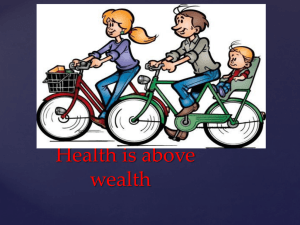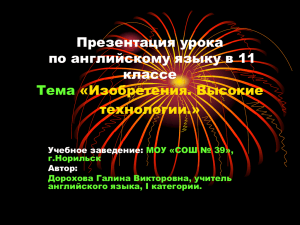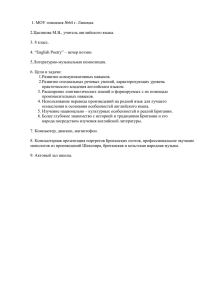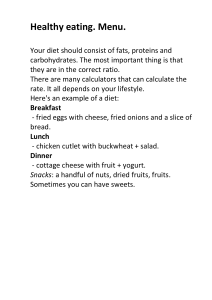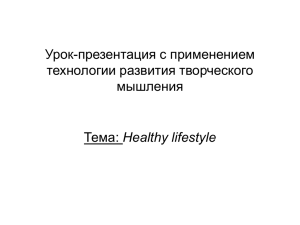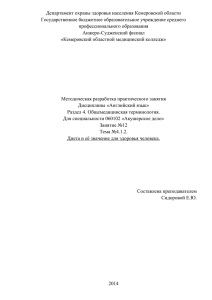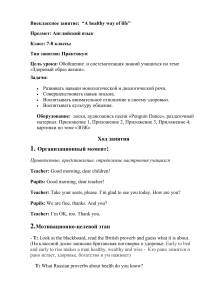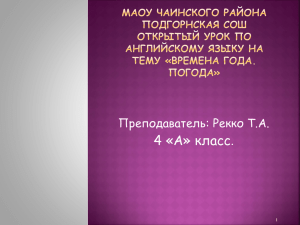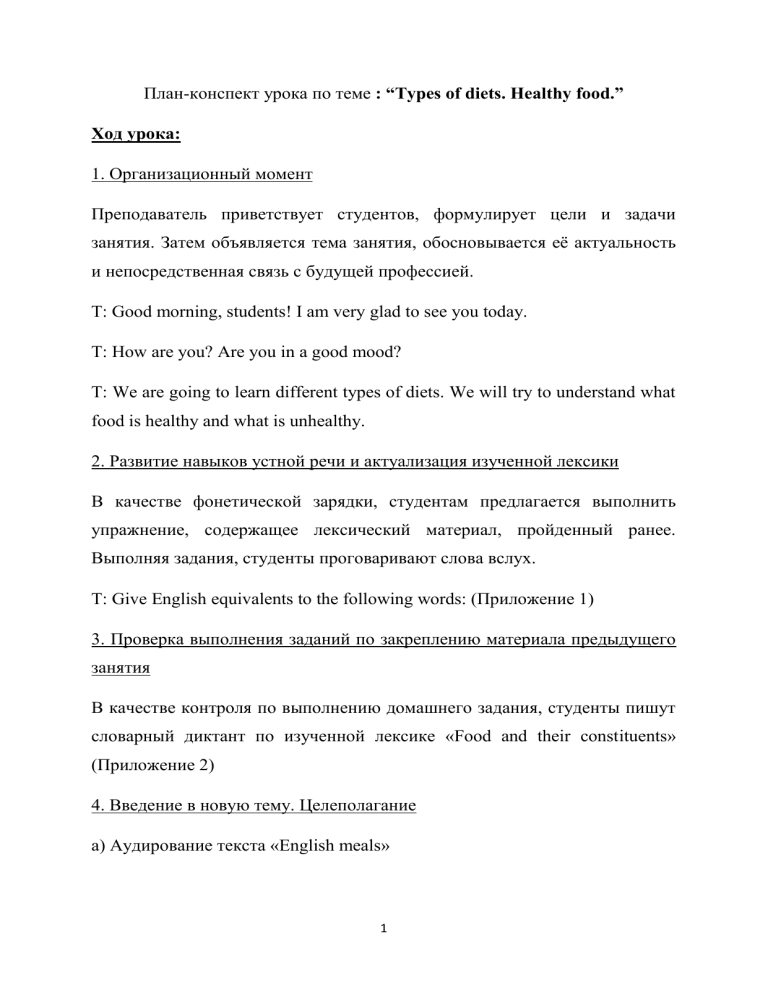
План-конспект урока по теме : “Types of diets. Healthy food.” Ход урока: 1. Организационный момент Преподаватель приветствует студентов, формулирует цели и задачи занятия. Затем объявляется тема занятия, обосновывается её актуальность и непосредственная связь с будущей профессией. T: Good morning, students! I am very glad to see you today. T: How are you? Are you in a good mood? T: We are going to learn different types of diets. We will try to understand what food is healthy and what is unhealthy. 2. Развитие навыков устной речи и актуализация изученной лексики В качестве фонетической зарядки, студентам предлагается выполнить упражнение, содержащее лексический материал, пройденный ранее. Выполняя задания, студенты проговаривают слова вслух. T: Give English equivalents to the following words: (Приложение 1) 3. Проверка выполнения заданий по закреплению материала предыдущего занятия В качестве контроля по выполнению домашнего задания, студенты пишут словарный диктант по изученной лексике «Food and their constituents» (Приложение 2) 4. Введение в новую тему. Целеполагание а) Аудирование текста «English meals» 1 Перед аудированием, преподаватель ставит перед студентами задачу – понять английский текст на слух, обращая внимание на произношение трудных слов и отмечая интонацию и логические паузы. T: Well, students, let’s work with the text. Mind the pronunciation of difficult words and right intonation. После определённого прочитанного абзаца, студентам предлагается повторить за преподавателем ряд труднопроизносимых слов. (Слова предварительно выписаны на доске). Затем прослушав текст, студенты выполняют лексическое упражнение (заполняют таблицу «Здоровая и вредная еда» Приложение 3). б) Чтение текста «Vegetarianism» Преподаватель предлагает студентам прочитать самостоятельно текст по теме «Vegetarianism», поставив перед ними задачу, понять главную мысль, а также получить необходимую информацию из прочитанного текста. Во время чтения, преподаватель индивидуально отрабатывает навыки чтения со студентами. В рамках контроля, преподаватель организует беседу со студентами, путем наводящих вопросов и реплик. (Обсуждение прочитанного текста проводится при открытых учебниках и тетрадях). T: So, students, say true or false: 1) A meatless diet is growing less and less popular, particularly with the young. (-) 2) Vegetarianism prohibits the consumption of meat and fish. (+) 3) Semi-vegetarians eat fish and sometimes chicken. (+) 4) Vegans include milk and eggs in their diet but no meat or fish. (-) 2 5. Закрепление и систематизация знаний Преподаватель организует работу в парах - составление диалога по теме «Vegetarianism». Примерные вопросы для обсуждения: - What is vegetarian? - What can semi-vegetarian eat? - What do ovo-lacto-vegetarians include in their diet? - What do lacto-vegetarians exclude from their diet? Активизация мыслительной деятельности студентов (Приложение 4). 6. Подготовка к домашнему заданию Преподаватель задает и объясняет домашнее задание на следующее занятие: а) краткий доклад по теме «Types of diets» б) студентам раздаются карточки с заданиями на закрепление пройденной на уроке темы «Vegetarianism» (Приложение 5) 7. Заключительный этап занятия: рефлексия, подведение итогов Преподаватель оценивает свою деятельность, а также деятельность студентов, подводит итоги, высказывает комментарии и пожелания. T: Do you like the lesson? What exactly? Why? What new information did you learn? 3 T: I liked the way you worked today. T: Now, our lesson is over. You are free. See you next time. 4 (Приложение 1) Translate from Russian into English: 1. диета, влиять, рост, здоровье Хорошая диета влияет на рост и здоровье. 2. сбалансированная диета, важный, человек Сбалансированная диета является важной частью для человека. 3. вода, необходимый, тип (диеты) Вода необходима к любому типу диеты. 4. кушать, слишком много, страдать от болезни Люди, которые кушают слишком много, страдают от болезни. 5. тело (организм), много, потребности Тело (организм) имеет много потребностей. 6. пить (3 формы), литры Человек выпивает 3 литра воды в день. (Приложение 2) Dictation –I I. Give English equivalents: 1. диета 2. здоровый 3. есть, кушать (3 ф.) 4. быть на диете 5 5. важный 6. рост 7. влиять 8. потребность 9. стакан молока 10. хорошая вещь II. Translate sentences from Russian into English: 1. Хорошая диета влияет на рост и здоровье. 2. Люди, которые кушают слишком много, страдают от болезни. 3. Тело (организм) имеет много потребностей. (Приложение 2) Dictation –II I. Give English equivalents: 1. пить (3 ф.) 2. здоровье 3. страдать от болезни 4. слишком много 5. нуждаться 6. требовать 7. сбалансированная диета 8. необходимый 6 9. вес 10. придерживаться диеты II. Translate sentences from Russian into English: 1. Сбалансированная диета является важной частью для человека. 2. Вода необходима к любому типу диеты. 3. Человек выпивает 3 литра (liters) воды в день. (Приложение 3) English Meals Vocabulary: 1) meal [miːl] – еда, прием пищи 2) to consist of – состоять из 3) porridge — (овсяная) каша 4) slice [slaɪs] of bacon ['beɪk(ə)n] – кусочек бекона 5) substantial — питательный (о пище); существенный, большой 6) poultry — домашняя птица 7) boiled — кипяченый, вареный 8) fried — жареный 9) snack — легкая закуска 10) to prefer [prɪ'fɜː] – предпочитать 11) biscuit ['bɪskɪt] - печенье 12) beer [bɪə] - пиво 7 13) roast chicken – жареная курица 14) to enjoy – наслаждаться 15) to taste - пробовать 16) delicious [dɪ'lɪʃəs] — восхитительный, прелестный; очень вкусный 17) to be busy ['bɪzɪ] – быть занятым 18) a lot of time – много времени 19) that’s why – поэтому Text. The usual meals in England are breakfast, lunch and dinner. Breakfast time is between 7 and 9 a.m. A traditional English breakfast is a very big meal. It consists of juice, porridge, one or two slices of bacon, eggs, toast, butter, jam or marmalade, tea or coffee. Many people like to begin with a glass of milk or a cup of tea or coffee. The second substantial meal of the day is lunch. Lunch is usually taken at 1 o'clock. Englishmen go to a cafe at this time. They take fish, poultry or cold meat, boiled or fried potatoes and all sorts of salad. Some people prefer to go to fast-food restaurants and have some snacks there, followed by biscuits and a cup of coffee, or a glass of light beer. Dinner time is between 6 and 8 p.m. The evening meal is the biggest and the main meal of the day. Very often the whole family eats together. They begin with soup, followed by fish, roast chicken, potatoes and vegetables, fruit and coffee. The British enjoy tasting delicious food from other countries, for example, French, Italian, Indian and Chinese food. Modern people are so busy that they 8 do not have a lot of time for cooking themselves, that’s why they usually go to cafes and restaurants Questions: 1. What are the usual meals in England? 2. When do the Englishmen have breakfast? 3. What is a traditional English breakfast? 4. What are the two substantial meals of the day? 5. When is lunch usually taken? 6. What does lunch consists of? 7. When do they usually have dinner? 8. What food do British people enjoy? Healthy Unhealthy (Приложение 4) Read and and translate the text. Vegetarianism While a meatless diet is growing more and more popularly with the young, researchers discover the health benefits of meat-free eating. 9 What is a vegetarian? By definition, vegetarianism prohibits the consumption of meat or fish, but some diets are more restrictive than other. •Demi- or semi-vegetarians eat fish and sometimes chicken, but not red meat. •Ovo-lacto-vegetarians include milk and eggs in their diet but not meat or fish. • Lacto-vegetarians have milk and yoghurt, as well as cheese made with vegetarian rennet, but no meat, fish or eggs. • Vegans do not eat any animal products at all, banning meat, fish, milk and eggs from their diets. • Fruitarians exclude pulses and cerials from the diet as well as all foods of animal origin. Fruitarians eat only fruit, honey, nuts and nut oils. •Macrobiotic followers have a diet consisting of ten different levels, which become progressively more restrictive. At first, animal foods are excluded, then fruit and vegetables as well. At the final "purist" level only brown rice is eaten. Vocabulary to discover - обнаруживать benefit - польза, преимущество definition - определение to prohibit - запрещать consumption - потребление restrictive - ограничительный, ограничивающий to include - включать rennet - фермент растительного происхождения, свертывающий молоко vegan - строгий вегетарианец 10 to ban - запрещать, исключать to exclude - исключать Say true or false: 1) A meatless diet is growing less and less popular, particularly with the young. (-) 2) Vegetarianism prohibits the consumption of meat and fish. (+) 3) Semi-vegetarians eat fish and sometimes chicken. (+) 4) Vegans include milk and eggs in their diet but no meat or fish. (-) Answer the questions - What is vegetarian? - What can semi-vegetarian eat? - What do ovo-lacto-vegetarians include in their diet? - What do lacto-vegetarians exclude from their diet? (Приложение 5) I. Make up dialogue: - What can vegans eat? - Приверженцы строгой вегетарианской диеты вообще не едят продукты животного происхождения. - Что кушают люди, питающиеся только фруктами? - Fruitarians eat only, honey, nuts and nut oils. - What is the microbiotic diet? 11 - Эта диета состоит из 10-ти различных уровней, вначале исключаются животные продукты, затем фрукты и овощи. На последнем уровне, употребляют в пищу только коричневый рис. II. Make up dialogue: - What is vegetarian? - Вегетарианец исключает употребление мяса в пищу. Что может есть полувегетарианец? - Semi-vegetarian can eat fish and sometimes chicken but not red meat. - What do ovo-lacto-vegetarians include in their diet? - Оволактовегетарианцы включают в свои диеты молоко и яйца, но не мясо и рыбу. - Что лактовегетарианцы исключают из своей диеты? Lacto-vegetarians have milk and yoghurt as well as cheese, but no meat, fish or eggs. 12
